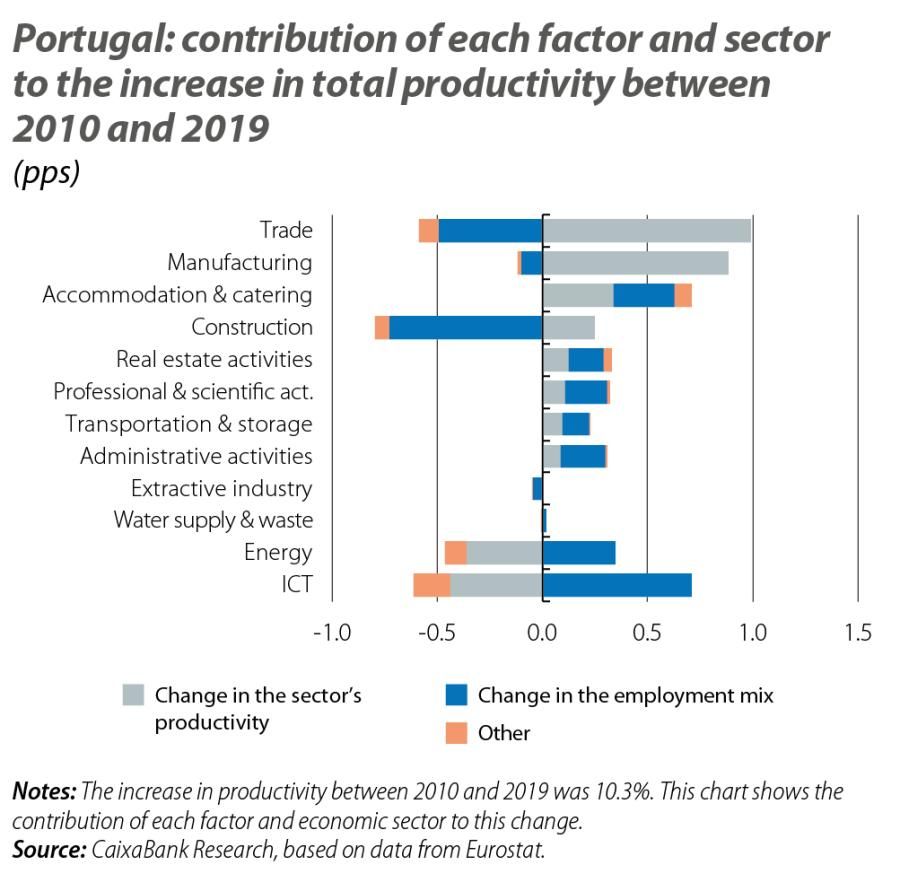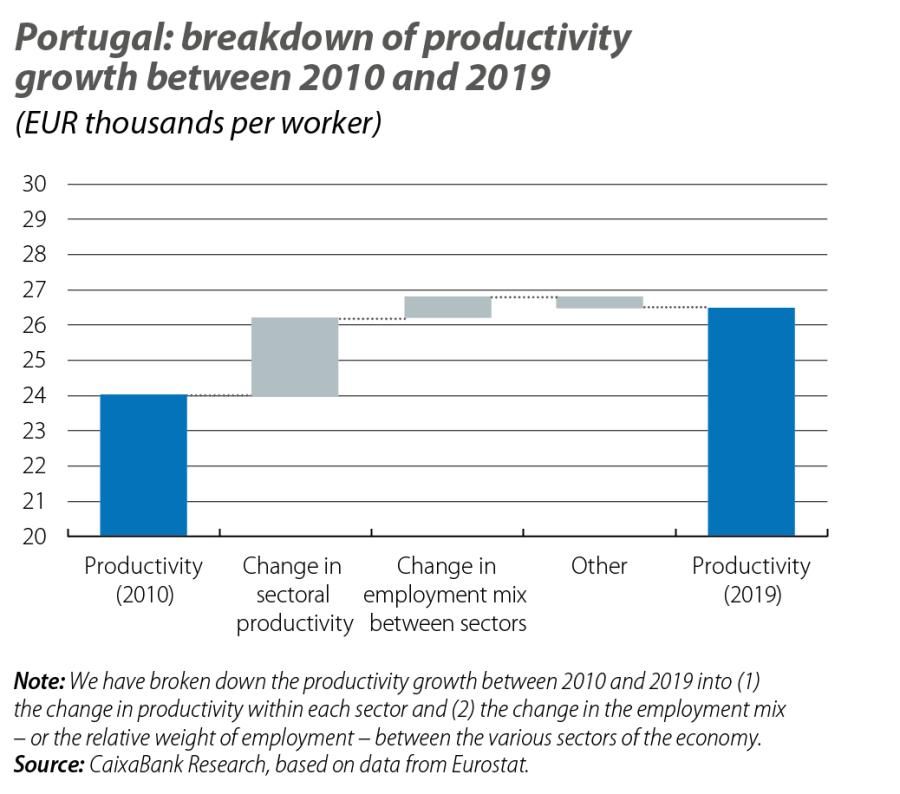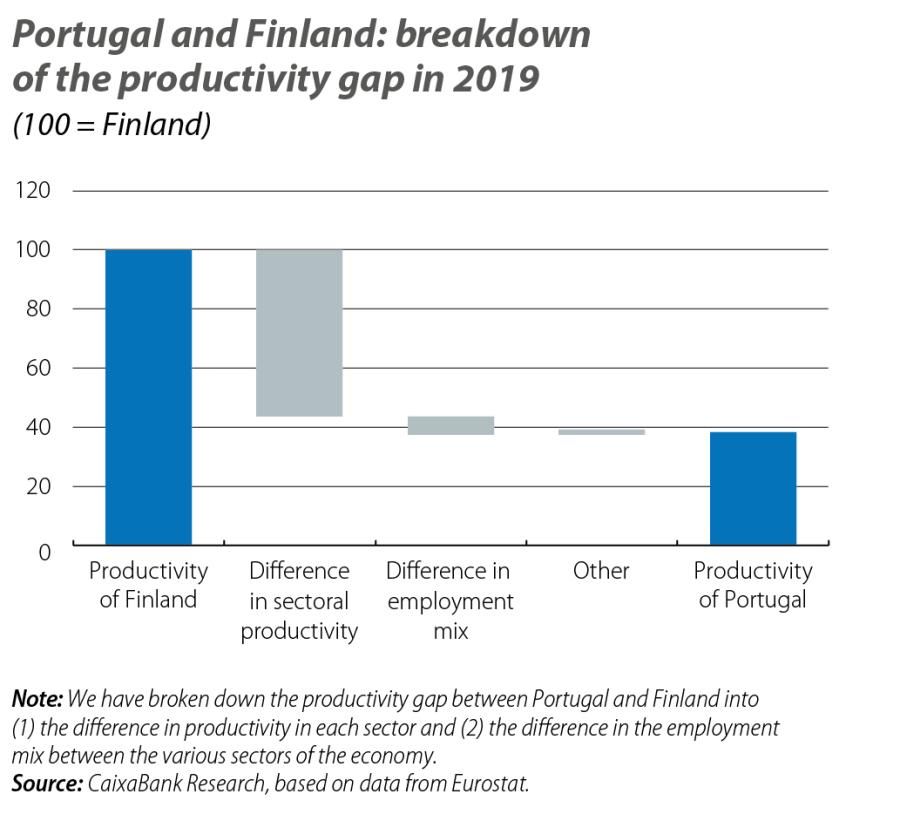Unravelling the behaviour of Portugal’s economic productivity

Portugal continues to stand out among its European counterparts for its low productivity. In 2019 it ranked ninth from the bottom among all EU countries, with an output generated per worker equivalent to 26,500 euros,1 well below that of Spain (43,400 euros) or Estonia (which in 2010 was 18% below Portugal and in 2019 lies 23% above, with 32,700 euros per worker). Although Portugal’s productivity has increased by 10% in the last 10 years, implying an average annual growth of around 1%, this is the fourth-worst performance in all of the EU.
An economy’s total productivity can be improved in two ways: by increasing productivity in the various economic sectors or by shifting employment from less productive sectors to others with higher productivity. In this Focus, we analyse what has been the basis of the improvement in Portugal’s productivity between 2010 and 2019.
- 1. The analysis carried out in this Focus only considers the sectors that make up the market economy considered by Eurostat, excluding financial and insurance activities, which means that general government administrations and the agriculture and fishing industries are also excluded. The choice of this period arises from the information available in Eurostat’s structural business statistics, only up until 2020, a year which we excluded from our analysis due to the distortions caused by the pandemic.
In Portugal, the improvement in the economy’s overall productivity between 2010 and 2019 occurred both because of the change in the structure of employment by sector and, above all, because of the improvement in productivity in virtually all economic sectors.
The first chart shows that trade was the sector that made the biggest contribution to the increase in total productivity during the period analysed, with an increase in gross value added (GVA) of more than 18% and a fall in employment of 0.5%. Trade was closely followed by manufacturing, with increases in GVA and employment of around 25% and 8%, respectively. In addition, accommodation and catering and the construction sector, in that order, provided a positive contribution to the improvement in productivity, albeit to a lesser extent than the two aforementioned sectors.

On the other hand, there were two sectors which made negative contributions to Portugal’s productivity: ICT and energy supply. In the former case, both its GVA and employment increased significantly, but the growth in employment was far greater, at almost 54%; in the case of energy, employment increased significantly, but GVA decreased slightly. However, despite a more than 20% drop in productivity in both cases, these two sectors remain the most productive in the Portuguese economy.
It is also important to note that, in addition to these two sectors, the water supply and waste, transportation and storage, real estate and manufacturing sectors had a productivity level that exceeded that of the country as a whole. Furthermore, in 2019, over 95% of the employed population worked in sectors where productivity had increased.
The contribution to the increase in productivity derived from the change in the sectoral composition of employment has been less significant than the effect mentioned above, but it has nonetheless been positive, unlike what has happened, for instance, in Spain.2 If the structure of employment observed in 2010 had remained unchanged in 2019, then the country’s total productivity would have been 1.5% lower than the level actually achieved.
This situation is primarily explained by the increase in employment in ICT,3 the sector with the second highest productivity per worker (105% above the national productivity). Although to a lesser extent, increases in employment in the energy sector, as well as in accommodation and catering, also made a positive contribution to the productivity gains. On the other hand, the construction and trade sectors made a negative contribution, because there was a fall in employment in these two sectors.
- 2. The change in the sectoral composition of employment in Spain made a negative contribution, of –1.2 pps, to the evolution of total productivity in the country, i.e. productivity in 2019 would have been 1.2% higher if the employment structure of 2010 had been maintained. For further information, see the Focus «Sectoral specialisation penalises the productivity of the Spanish economy» in the MR11/2023.
- 3. Employment in this sector increased from 2.5% of the total employment in the economy in 2010 to 3.5% in 2019.

This analysis of the composition of employment allows us to go further in our conclusions; in fact, the sectoral change in employment could have had a more positive impact if the employment growth had been channelled into more productive sectors. As an example, if the employment generated in the accommodation and catering sector had been channelled into a sector with higher productivity, such as ICT, then productivity growth could have reached 15%.
The increase in productivity in the Portuguese economy between 2010 and 2019 (10.3%) falls short of the increase observed in the Finnish economy over the same period (13.4%).4 As a result, the productivity gap between the two economies has widened: the productivity of the Portuguese economy was around 60% lower than that
of Finland in 2010 and has slipped to 61% lower in 2019.
Most of this difference is explained by the lower productivity of Portugal’s economic sectors compared
to those of Finland, particularly manufacturing, trade and construction, while the sectors with the closest productivity levels were the extractive and energy supply industries. If Portugal had Finland’s labour specialisation, then the productivity of the Portuguese economy would be 13.5% higher; that is, the productivity gap relative to the Finnish economy would be reduced to 55.6% (still a very wide gap). However, if Portugal’s economic sectors had a productivity level equivalent to that registered in the same sectors in Finland, and if we maintained Portugal’s employment structure in 2019, then the gap with respect to Finland would be reduced to around 6%.
- 4. We have chosen to use Finland for a comparison with Portugal as it accounts for a similar proportion of the euro area’s total GDP.

n short, Portugal faces significant productivity challenges, which reveal a limited capacity to generate value compared to other European countries. It is essential to implement specific strategies and investments in order to stimulate better economic performance in the country and improve the population’s standard of living, and this should be done without delay. After all, if productivity in the countries of Europe evolves over the next 10 years at the same rate as it did between 2010 and 2019, Portugal will fall to penultimate position in the EU ranking, ahead of only Greece.


